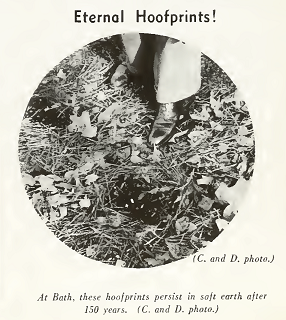
Legend relates that on a Sunday morning about church time, Jesse Elliott and some companions planned to race their horses along the main street of Bath. Elliott mounted and spurred his horse, and as it raced off, he leaned forward shouting in its ear: "Take me in a winner or take me to Hell." Promptly the horse dug its hooves into the soft earth, throwing Elliot against a tree and killing him instantly. Some believe that the horse was actually the devil in the form of a horse.
Tradition maintains that the holes, located just off N.C. 1334, about 3.3 miles west of Bath, have survived every known attempt to permanently eradicate or alter them. Although the holes are located at the edge of a forested area, no vegetation grows inside them. None of the pine needles from the thick mat surrounding the holes ever remains in the earthen saucers. On their way to school, children have deposited various kinds of debris in the depressions only to find that the holes are empty upon their return from school. Countless visitors to the site have experienced the same phenomena.
Scientists have conducted studies at the site to provide an objective explanation of the intriguing holes. Among the most popular theories are that the depressions are vents for a subterranean water pocket or the result of salt veins.